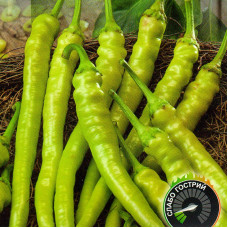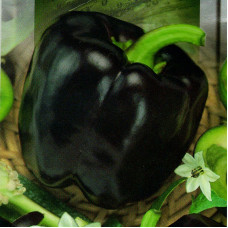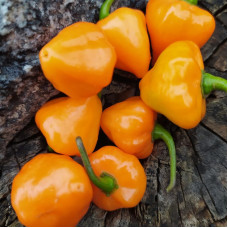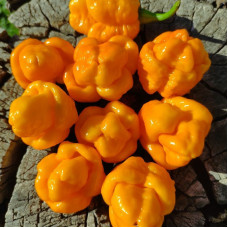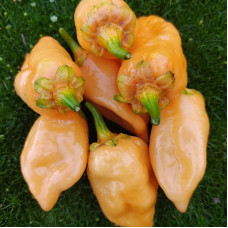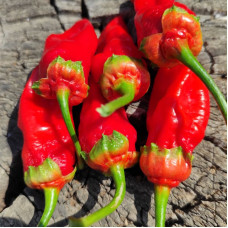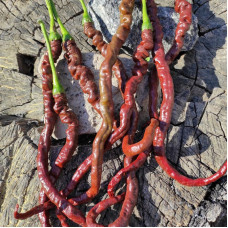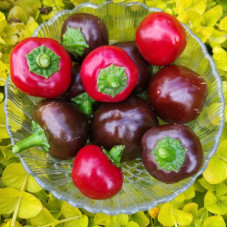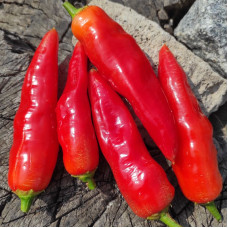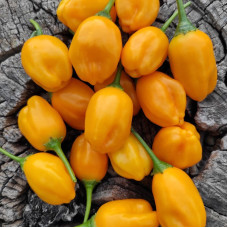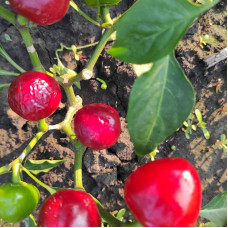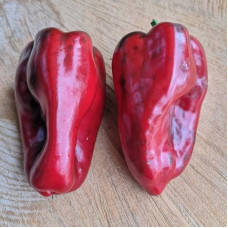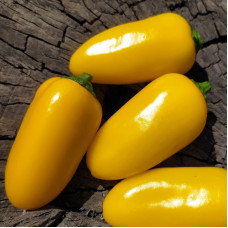In stock
Product Code: 16132
Sweet pepper «Anastasia» - mid-season variety. The period from germination to the beginning of ripeness is 120-130 days. The bush is 60-80 cm high. The fruits are large, weighing 200-250 grams, conical in shape, 12-15 cm long, 8-9 cm in diameter, dar..
$0.99
In stock
Product Code: 16118
Sweet pepper «Andrea» - mid-early variety of sweet pepper of the Hungarian type. The fruits are slightly ribbed, weighing 150-180 grams, 12 cm long, 6-7 cm in diameter. In technically ripe form, the fruits are yellow, and in biological form - red. Th..
$0.99
In stock
Product Code: 16162
Hot pepper (bitter) «Caperino chili» - mid-season variety. The fruits resemble red cherry tomatoes. The bush grows low, compact. Fruits weigh 10-20 grams, round in shape, in a state of technical ripeness they have a green color, and in biological rip..
$1.99
In stock
Product Code: 16121
Sweet pepper «Cruzader» F1 - early, disease-resistant hybrid. Intended for cultivation in open ground. The plant is medium-sized, abundantly foliated, powerful. Quickly adapts to various growing conditions. Uniformly loaded with ovaries. Has strong i..
$4.49
In stock
Product Code: 16163
Hot pepper (bitter) «Pepperoni Cigarette Bionda» - highly productive mid-season variety. The bush grows tall, requires garter. The fruits are long, cylindrical. In technical and biological maturity, the fruits have a light green color. The fruits are..
$0.99
In stock
Product Code: 16119
Sweet pepper «Dvorana» - mid-early variety of sweet pepper of the Hungarian type. Created for growing in film greenhouses and in open ground. Fruits are conical, thick-walled, 12-14 cm long, with an average weight of 120-140 grams. The color in techn..
$0.99
In stock
Product Code: 16120
Sweet pepper «Don» F1 / Don F1 - early ripening, productive hybrid pepper with red fruits of the Hungarian type. The hybrid is actively grown both in greenhouses and in open ground. The ripening period from planting seedlings is 60-65 days. The plant..
$2.99
In stock
Product Code: 16124
Sweet pepper «Gull» F1 - mid-early hybrid of cuboid red thick-walled pepper of the Bulgarian type. Ripening period 70-75 days from planting seedlings. Demonstrates excellent results when grown in open and closed ground. A strong plant (up to 1 m) wit..
$3.49
In stock
Product Code: 16123
Hot pepper (bitter) «Poseidon» - very early and high-yielding variety of hot pepper. The vegetation period lasts approximately 90-110 days. Unpretentious to growing conditions, so it can be planted in open and closed soils (greenhouse). The plant is ..
$0.99
In stock
Product Code: 16161
Sweet pepper «Black square» - early ripening variety, suitable for growing in open and closed ground. Fruits from dark purple to almost black, cuboid, wall thickness - up to 7 mm, fruit weight - 110-170 grams.
The variety is resistant to a complex..
$0.99
In stock
Product Code: 16122
Sweet pepper «Pirouette» F1 - a hybrid of early sweet pepper for growing in open ground or using temporary shelter, tunnels or in greenhouses. Pepper seeds are sown in seedling cassettes. The plant develops quickly. Forms the first harvest 60 days af..
$4.49
In stock
Product Code: 16164
Hot pepper (bitter) «Purple Pearl» - decorative, herbaceous plant, can be grown as a houseplant in pots and containers. Bush up to 45 cm high, with a purple stem and dark green leaves. The fruits are very decorative, round-elongated, 1.5 cm in diamet..
$0.99
In stock
Product Code: 16023
Hot pepper (bitter) «Orange lantern» - mid-season variety, ripening period 110 days from planting seedlings. Bush is compact, height - 30 cm. Anthocyanin branches. Fruits are triangular, orange, diameter 3 cm. Excellent for fresh eating, sauces and a..
$1.99
In stock
Product Code: 16026
Hot pepper (bitter) «Yellow Trinidad Moruga Scorpion» - the bush is 80 cm high. The yield is high. The fruits are beautifully shaped, similar to flowers, bright yellow. The taste of the pepper is sweet and fruity.
The fruits of this variety are us..
$4.99
In stock
Product Code: 16020
Hot pepper (bitter) «Wartryx Peach Gum» - mid-season variety. Ripens 120 days after planting seedlings. This is a peach version of the red-fruited Wartryx. It has retained the high pungency and the feature of Bubblegum peppers, coloring the sepals in..
$1.99
In stock
Product Code: 16031
Hot pepper (bitter) «7 Pot Bubblegum Red» - belongs to a unique varietal group, the peculiarity of which is that the sepal and stalk are colored according to the color of the fruit. Bush height 60-80 cm. Productive.
The fruits are red, with an int..
$1.99
In stock
Product Code: 16024
Hot pepper (bitter) «Thunder Cacho Brown» - mid-season variety, vegetation period 120 days. Comes from the red-fruited Thunder Mountain Longhorn. The bush is high 50-60 cm. Good yield. The fruits are long, wavy and thin 18-25 cm, rich chocolate color..
$0.99
In stock
Product Code: 16035
Hot (bitter) pepper «Chocolate cherry» - a very interesting and productive variety of hot pepper. The vegetation period is 120-130 days. The fruits are not large, weighing 30 - 50 grams. Wall thickness up to 5 mm. The plant is up to 60 cm high, compa..
$0.99
In stock
Product Code: 16219
Sweet pepper «Bugai» - early ripening variety. The period from germination to the beginning of ripeness is 120-130 days. Bushes are 50-60 cm high. Fruits are large, weighing 300-500 grams, cuboid, yellow-orange color. Wall thickness is 8-10 mm...
$0.99
In stock
Product Code: 16018
Hot pepper (bitter) «Aji Cristal» - mid-season variety, from planting seedlings to ripening: 90 days. Height about 1 meter, gives large yields of cone-shaped fruits, 10-12 cm long. When ripening, the fruits change color from cream to red-orange.
T..
$1.99
In stock
Product Code: 16022
Hot pepper (bitter) «Oro de Ecuador» - mid-season variety, ripens 120 days after planting seedlings. This is a tasty pepper variety. The plant is tall - 1 m. The fruits are round, bright yellow. The taste is soft fruity and berry. Good yield.
Used..
$1.99
In stock
Product Code: 16028
Hot pepper (bitter) «Red cherry» - mid-early variety. The vegetation period from germination is 100-110 days. The bush is semi-standard, 40-60 cm high. The fruits are round, smooth, 3-5 cm in diameter, red. The pulp is dense, spicy in taste.
Pairs..
$1.99
In stock
Product Code: 16019
Hot pepper (bitter) «Ancho San Luis» - mid-early Mexican variety, ripens approximately 90 days after planting seedlings in the soil, bush height 60 cm. Fruits are cone-shaped, ribbed, red, fleshy walls, -medium thickness, crispy.
Green fruit..
$1.99
In stock
Product Code: 16027
Hot pepper (bitter) «Jalapeno Lemon Spice Giant №1» - mid-early variety. The fruits are larger than most jalapenos, the shape is typical for jalapenos. Ripens from green to lemon. Sweet and juicy. Pleasant aroma with notes of citrus. Bush height 40 c..
$1.99
Pepper Features
Today, there are over 700 types of pepper seeds. Initially, this word denoted a genus of plants of the Pepper family. Now this terminology is used depending on the scope. In cooking, there are three main types: white, green, black. Their difference is only in ripeness and time of collection. A popular variety is the thick-walled specimen.
Initially, pepper appeared in Mexico and Guatemala, Columbus brought it to Europe, like potatoes. First, he was entrenched in the culinary culture of Spain, then England, Hungary, Greece, Bulgaria. It appeared on our territory in the sixteenth century and took root so much that local farmers began to seat it at an enviable speed. And with the advent of science in human life, peppers were found to be bred, creating hybrid species and all kinds of product variations. After 5 centuries, this vegetable has not lost its former popularity, but has only become even more firmly entrenched in the gastronomic cult of almost all countries of the world.
Pepper dishes have been familiar to us since childhood, it can be stuffed, baked, canned or chopped into lecho. Unfortunately, today's prices make it an unaffordable luxury to be able to buy natural vegetables. For residents of country houses, this is all the more not the most rational solution. Therefore, more and more people do without shops, growing vegetable products in the garden. Do not be upset or the inhabitants of the apartments – some peppers can be grown in a pot. To carry out this process, only favorable conditions for the life of the plant and high-quality pepper seeds are needed, which will be discussed further.
Initially, pepper appeared in Mexico and Guatemala, Columbus brought it to Europe, like potatoes. First, he was entrenched in the culinary culture of Spain, then England, Hungary, Greece, Bulgaria. It appeared on our territory in the sixteenth century and took root so much that local farmers began to seat it at an enviable speed. And with the advent of science in human life, peppers were found to be bred, creating hybrid species and all kinds of product variations. After 5 centuries, this vegetable has not lost its former popularity, but has only become even more firmly entrenched in the gastronomic cult of almost all countries of the world.
Pepper dishes have been familiar to us since childhood, it can be stuffed, baked, canned or chopped into lecho. Unfortunately, today's prices make it an unaffordable luxury to be able to buy natural vegetables. For residents of country houses, this is all the more not the most rational solution. Therefore, more and more people do without shops, growing vegetable products in the garden. Do not be upset or the inhabitants of the apartments – some peppers can be grown in a pot. To carry out this process, only favorable conditions for the life of the plant and high-quality pepper seeds are needed, which will be discussed further.
Pepper seed classification
As mentioned, there are an incredible number of varieties. So many that a person who has no experience in agriculture will not understand what's what. & nbsp; Of all the species and subspecies classifications, one can single out the most familiar to every European. Pepper seeds are divided into the following types:
- Hot pepper. The most popular variety is chili, even hotter Jalapeno, waxy Hungarian, Jamaican, red Cherry pepper and others. Despite the pungency, they contain a large amount of useful substances. They are digestion catalysts, used for chronic diseases, diseases of the stomach and intestinal tract in some cases. In the East, flatulence is cured with the help of the pungent Habanero. Due to its small size in most species, it is well suited for growing at home. The process of sowing seeds is recommended to be carried out in winter. You also need to carefully approach the preparation of the soil, laying it out in layers: humus, leafy soil, sand. Indoor hot pepper bushes do not respond well to transplantation, so you need to take care of the "growth" pot in advance.
- Sweet pepper. The second name, which is more popular, is Bulgarian. There are different colors: from yellow to purple. Growing this type is a more complicated procedure and is unlikely to suit inexperienced farmers. Preparing for planting takes a lot of time and knowledge. Sowing pepper seeds – the beginning of the most crucial period, ending with the emergence of seedlings. After all, on the "conscience" the seeds themselves are only 20% failures, 80% - non-compliance with growing technologies. Therefore, it is more reliable to sow germinated seeds for seedlings, which reduce the likelihood of poor germination. To begin with, the purchased seeds must be soaked in infused water with aloe leaves or a small amount of potassium permanganate. This will not harm the plant in any way, but rather relieve harmful bacteria and damage. Seeds should be watered abundantly until the first leaves appear.
How to choose seeds
There are no special technologies for choosing pepper seeds, they are the same and differ in what fruits we get at the end. It is worth choosing, starting from the place of residence: a private house or an apartment. Also, an important factor in choosing is whether it is late or early. The first type matures in about 140 days, while the second takes almost half the time. It is imperative to find out if you are allergic to one or another variety, since this product can also have a negative effect on a sick organism.





